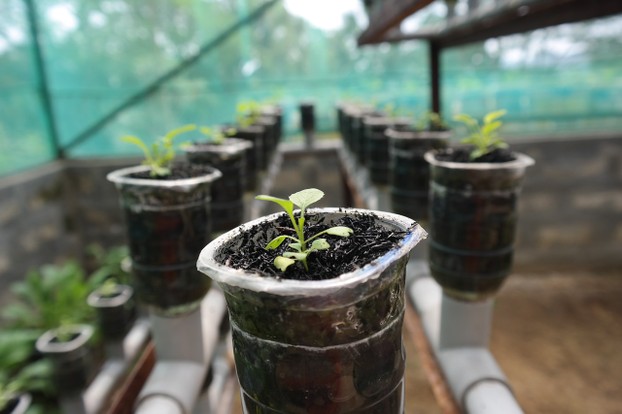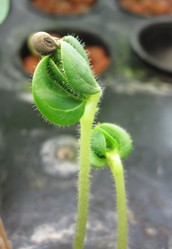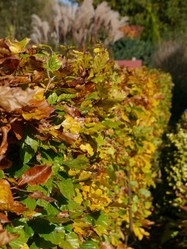London is a city with more space than the cities of the north and midlands have, but land is very expensive and the price of houses is so excessive that ordinary people cannot afford to buy. Any land is snapped up very quickly,so while there are a few urban farms in the city, they occupy a small fraction of the land. But the demand for food in a conurbation of ten million people is great, and most of it comes from outside. But there are enterprising people who grow either on roof tops or in cellars, and while there is no space in cellars or tunnels for animals, who should not be imprisoned thus, it is possible to grow certain vegetables beneath the ground if the conditions are made right.
You have all seen pictures of London during the Blitz, with citizens crammed into tunnels where they slept on the ground while bombers pounded the city above. The bombers have gone, Germany is now a much-valued friend and ally, but the tunnels remained, dark and silent, almost forgotten, but not by everyone. Then along came two friends, Steven Dring and Richard Ballard, men with an ecological conscience and a yearning to use urban space to grow food for cities. Having looked above ground their fears were confirmed, there was no space for urban farming,but what about the tunnels, they wondered? It soon became clear that they would be permitted to rent the tunnels for growing, and so the enterprise,Growing Underground, began.
There are advantages and disadvantages to underground farming, and to be exact what they are doing is more akin to market gardening than to traditional farming, for it resembles a market garden more than it does a farm. The two friends, however,are not ones to cavill over tight definitions. The lack of light is remedied by low cost, low intensity led lights. There is a water recycling system and there are fans to circulate air. This is essential as plants kept in still air can develop fungal diseases such as botrytis, which is always lethal to the plants that suffer it. On the other hand the lack of soil means that there are no weeds, and as one who has had to struggle with weeds on an allotment that is one sure advantage. The growers are also very near to their markets, which are restaurants and some high quality greengrocers in London, which cuts down their costs. The growing of vegetables in the cities is very ecologically beneficial, as it cuts down air miles and CO2 production, and they also make the most of otherwise unproductive urban space.
The farm specializes in herbs, with about twenty varieties being grown. These include peashoots, red mustard, chives and coriander, among others. Clearly the hydroponic system cannot be suitable for all crops, and the tunnels, which had space for eight thousand people are now fully used up. But specializing in a crop for which there is a good market is advantageous as it enables the growers to develop their expertise.








 Pilgrimage. A review29 days ago
Pilgrimage. A review29 days ago
 Leo the Fourteenthon 05/09/2025
Leo the Fourteenthon 05/09/2025
 The Melsonby Hoardon 03/25/2025
The Melsonby Hoardon 03/25/2025



Comments
I just noticed a badly constructed answer a few places down. In have been having some trouble with the tablet and it seems to be going wrong. I am going to have to move to a newer machine. Sorry.
Not on the same scale as Kew.
Richard Sanders Rogers (Dec. 2, 1861-March 28, 1942) classified the Rhizanthella "root-flower" orchid genus. The Royal Adelaide Hospital had him on its staff as consulting physician from 1897 onward. Dr. Rogers identified Australian, New Guinea-an and New Zealander orchids.
Perhaps such specimens may be available for scientific scrutiny if not general-audience appreciation at some Australian institution.
Might there be an Australian counterpart or equivalent to Kew Royal Botanic Gardens?
Probably.mit Kew does not have a specimen who kn
Owns where You would get one.
Thank you!
The first scientific description of that underground-flowering, underground fruiting palm species, Pinanga subterraneana, was realized by Royal Botanic Gardens researchers and their partners!
That perhaps would make it likely that specimens would be at Kew Gardens, correct?
If Britain has any examples of these plants You will find them at Kew Gardens
English Wikipedia describes Pinanga palm- and Rhizanthella orchid-family members as the only plants known to flower and fruit underground!
Rhizanthella, commonly called underground orchids, is known to us since the 1928 scientific classification by Australian doctor and orchid-ist Richard Sanders Rogers (Dec. 2, 1861-March 28, 1942).
Might the British isles have Rhizanthella specimens for plant lovers to study and visit?
Or would travel to the Land down under be agreeably necessary?
I have not hearď of this plant, but it has clearly found an ecological niche. Borneo is species rich and has yet to be fully studied.
Online sources from June 2023 discuss a Borneo-an plant scientifically named Pinanga subterranea.
The above-mentioned palm flowers and fruits underground.
Might you have heard tell about it?
Not necessarily replaced,but cleaned.